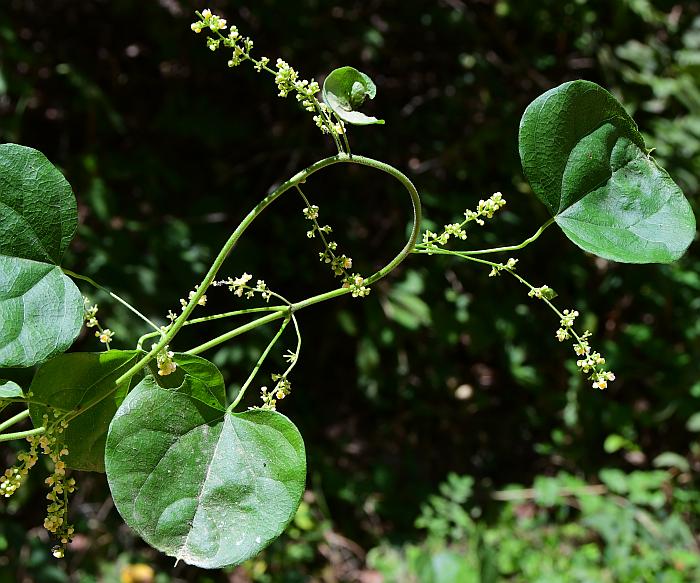Cocculus carolinus (L.) DC.
Snailseed, Carolina Moonseed

Native
CC = 5
CW = 0
MOC = 36
© SRTurner
Cocculus carolinus (L.) DC.Snailseed, Carolina Moonseed | |
 |
Native CC = 5 CW = 0 MOC = 36 |
© SRTurner |
|
Family - Menispermaceae Habit - Perennial vine, relatively slender, often woody toward the base, lacking tendrils or spines, dioecious. Stems - Vining, to 5 m.
Leaves - Alternate, simple, petiolate, not peltate. Blades 4-15 cm long, 3.0-8.5 cm wide, triangular or ovate-cordate in outline, undivided or shallowly 3- or 5-lobed, with 5 main veins from the base, the upper surface glabrous or sparsely to densely hairy, the undersurface sparsely to densely hairy, the base truncate to moderately cordate, rounded to bluntly pointed at the tip or the tips of the lobes, usually mucronate or apiculate. A large variation in leaf blade shape may be evident on a single plant.
Inflorescence - Axillary racemes or panicles, to 12 cm long.
Flowers - Actinomorphic, hypogynous, lacking bractlets. Sepals usually 6, 1.5-2.5 mm long, free. Petals 6, free, relatively inconspicuous, white. Staminate flowers with the stamens usually 6, free and distinct, the anthers 4-locular and opening by longitudinal slits. Pistillate flowers with 6 separate pistils, each with 1 locule, the placentation marginal. Style 1 per pistil, short.
Fruits - Globose 1-seeded drupes, 5-8 mm long, red at maturity, the endocarp discoid, the rim and thickened margin transversely ridged, both sides concave.
Flowering - July - August. Habitat - Forests, swamps, upland prairies, glades, bluffs, streambanks, old fields, fencerows. Origin - Native to the U.S. Lookalikes - Calycocarpum lyonii, Menispermum canadense, some species of Smilax. Other info. - This interesting species can be found mainly in the southern 1/3 of Missouri. Its U.S. range is largely within the southeastern quadrant of the country. The plant can be identified by its leaves, the lowermost of which have a characteristic fiddle shape. This important character can appear to be missing if the lowermost leaves are buried in other vegetation, since upper leaves in the vicinity of the inflorescences can be unlobed and even wider than long. These upper leaves will usually be apiculate, having a conspicuous hairlike projection at the tip, and the petioles of all leaves will be attached at the margin (i.e., not peltate). The red fruits containing a stone resembling a snail or 3/4 moon. Photographs taken along the shores of the Current River, Shannon County, MO., 7-24-04 (DETenaglia); also at Holly Ridge Conservation Area, Stoddard County, MO, 8-7-2022, and Sand Prairie Conservation Area, Scott County, MO, 8-8-2022 (SRTurner). |